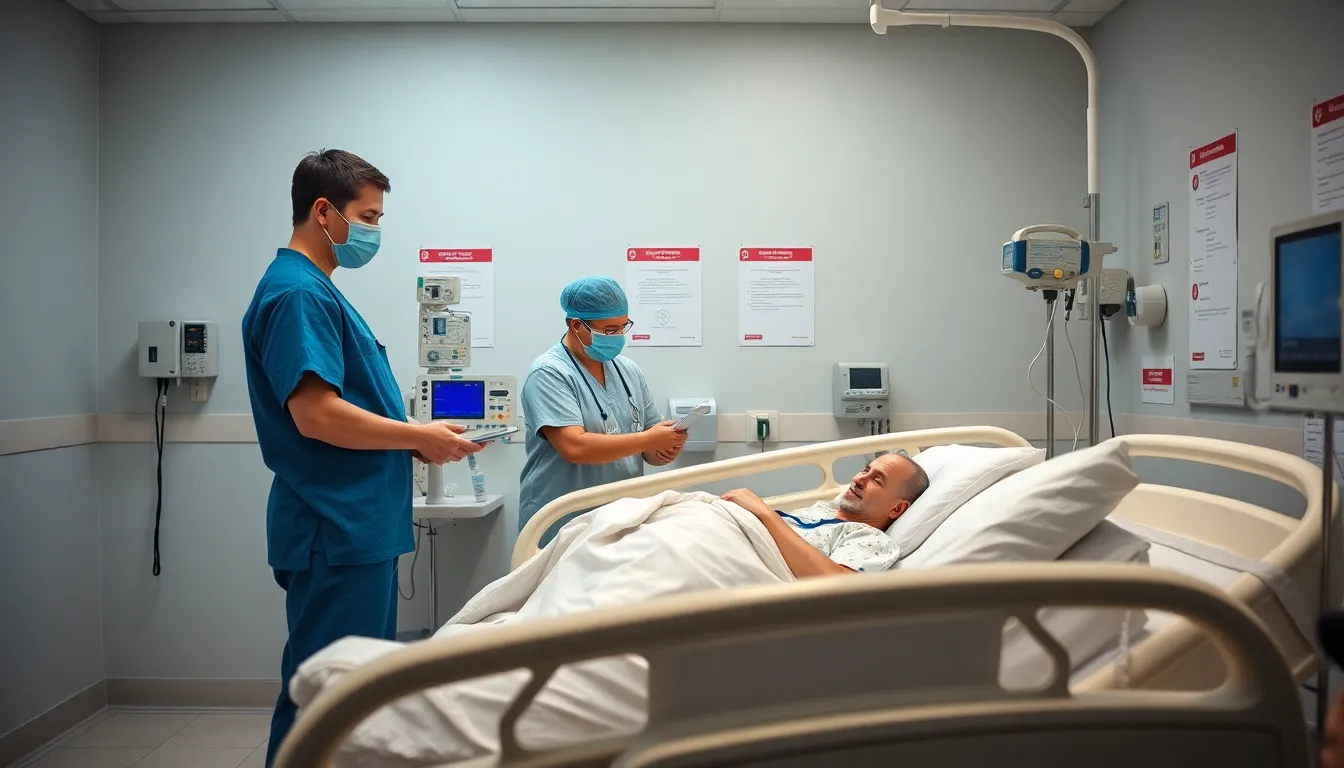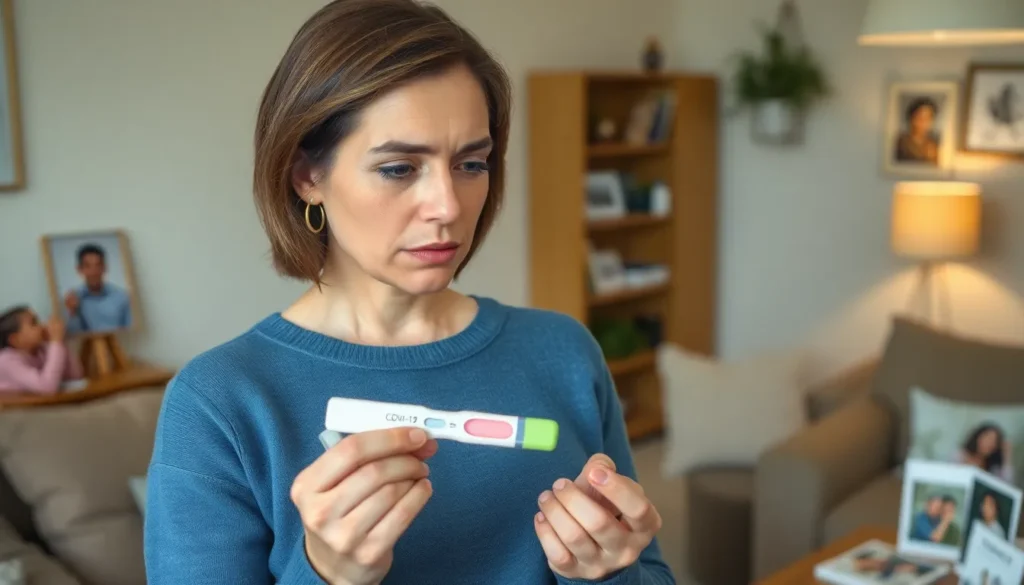Table of Contents
ToggleAs 2024 unfolds, the COVID-19 pandemic continues to shape lives worldwide. With new variants emerging and vaccination efforts ongoing, many are finding themselves navigating the complexities of testing positive for the virus. This experience can be overwhelming, filled with uncertainty and questions about health, safety, and next steps.
Understanding the implications of a positive test result is crucial. It not only impacts personal health but also affects family, friends, and the broader community. This article aims to provide clear insights into what to expect if someone tests positive for COVID-19 in 2024, including symptoms, isolation guidelines, and the importance of staying informed.
Overview of Covid-19 in 2024
Covid-19 continues to influence global health in 2024. Variants of the virus remain in circulation, with Omicron subvariants being the most prevalent. Vaccination efforts have advanced, and booster shots are recommended for populations most at risk.
Health authorities emphasize the importance of monitoring symptoms typical of Covid-19, such as fever, cough, fatigue, and loss of taste or smell. Individuals testing positive must adhere to defined isolation guidelines to prevent further transmission. Isolation typically lasts for at least five days, with the possibility of extending if symptoms persist.
Community awareness plays a crucial role in managing the pandemic. Reporting positive cases helps public health officials in tracking outbreaks, enabling timely interventions. Staying informed about local Covid-19 statistics and updates on variants supports better decision-making regarding health and safety measures.
Preventative measures, such as wearing masks in crowded settings and regular handwashing, remain vital. These actions contribute to minimizing virus spread, especially during seasonal spikes in cases. Maintaining open communication among peers about health status fosters a supportive environment as the community navigates the ongoing challenges posed by Covid-19.
Current Statistics and Trends


COVID-19 remains a significant public health concern in 2024, with evolving statistics that reflect current trends. Monitoring global infection rates and regional variations provides important context for understanding the pandemic’s status.
Global Infection Rates
As of October 2024, over 700 million confirmed COVID-19 cases have been reported worldwide, with approximately 6.9 million deaths attributed to the virus. The World Health Organization (WHO) highlights that approximately 15% of recent infections are severe cases requiring hospitalization. The prevalence of Omicron subvariants accounts for nearly 80% of new cases globally, reflecting continued mutations and adaptations of the virus. Increased vaccination rates have contributed to a decline in the severity of cases, with about 78% of the world’s population having received at least one vaccine dose. Continuous surveillance remains critical as variants emerge and evolve.
Regional Variations
Regional COVID-19 statistics show notable disparities in infection rates and vaccination coverage. Areas with high vaccination rates, like Northern Europe, experience lower hospitalization rates and milder outbreaks. In contrast, regions with lower vaccination rates, such as parts of Southeast Asia and Eastern Europe, report higher daily case numbers and mortality rates. Current data indicates that the United States reports around 30,000 new cases daily, while countries like India and Brazil report around 10,000 and 8,000, respectively. Variations in public health measures and adherence to guidelines play crucial roles in these discrepancies. Enhanced monitoring and targeted interventions are essential to control outbreaks in higher-risk regions.
Understanding the Impact of Testing Positive
Testing positive for COVID-19 in 2024 has significant implications for individual health and community welfare. Each positive test prompts immediate actions and considerations to ensure both personal recovery and collective safety.
Symptoms and Severity
Typical symptoms of COVID-19 include fever, cough, fatigue, and loss of taste or smell. Severity varies; about 15% of cases require hospitalization, particularly among unvaccinated individuals or those with underlying health conditions. Monitoring symptoms is crucial. Those with mild symptoms often recover at home, while severe cases demand immediate medical attention. The prevalence of Omicron subvariants tends to correlate with milder symptom expression, yet vigilance is necessary to detect any escalation that could lead to complications.
Psychological Effects
Testing positive for COVID-19 often leads to heightened anxiety and stress. Isolation can exacerbate feelings of loneliness and fear, impacting mental health. Individuals may experience uncertainty about their health or the health of loved ones. Open communications within the community can alleviate some of these psychological burdens. Access to mental health resources, like counseling or support groups, is essential to aid those grappling with the emotional fallout of the pandemic. Promoting mental health awareness remains critical as society continues to navigate COVID-19’s ongoing effects.
Treatment Options Available
Several treatment options exist for individuals testing positive for COVID-19 in 2024. These options include antiviral medications and supportive care strategies tailored to alleviate symptoms and promote recovery.
Antiviral Medications
Antiviral medications play a significant role in managing COVID-19. The Food and Drug Administration (FDA) has authorized several antivirals for emergency use. Examples include:
- Paxlovid: Administered as a five-day course, it reduces the risk of hospitalization and severe illness, particularly for high-risk individuals.
- Remdesivir: Administered intravenously, it shortens recovery time in hospitalized patients, benefiting those with moderate to severe symptoms.
- Molnupiravir: An oral medication used for those at increased risk of severe outcomes, providing an alternative when other treatments are unavailable.
Healthcare providers assess patient eligibility for these medications based on factors like age, health history, and symptom severity.
Supportive Care Strategies
Supportive care strategies aim to ease symptoms and enhance recovery. Key components of supportive care include:
- Hydration: Maintaining hydration through fluids helps alleviate fever and support overall health.
- Rest: Prioritizing rest allows the immune system to function optimally while combating the virus.
- Symptomatic Relief: Over-the-counter medications, such as acetaminophen or ibuprofen, help reduce fever and alleviate discomfort.
- Monitoring Symptoms: Regularly tracking symptoms allows for timely medical intervention if they worsen.
Employing these supportive measures ensures a holistic approach to treatment, facilitating an effective recovery process for individuals diagnosed with COVID-19.
Preventive Measures for 2024
Preventive measures remain crucial in combating COVID-19 in 2024. Adhering to recommended guidelines helps minimize transmission rates and protect communities.
Vaccination
Vaccination is the most effective preventive measure. Vaccines, including booster shots, boost immunity against variants, particularly for at-risk populations. Health authorities recommend staying up to date with vaccination schedules. Countries report varying vaccination rates, with proactive efforts in areas lagging behind.
Mask-Wearing
Mask-wearing in crowded or high-risk settings reduces the spread of respiratory droplets. Properly fitted masks significantly protect against infection, especially indoors and during peak times of viral transmission.
Hand Hygiene
Regular handwashing with soap and water or using hand sanitizer with at least 60% alcohol is essential. Frequent hand hygiene prevents virus transmission, particularly after being in public spaces or touching surfaces.
Social Distancing
Maintaining adequate social distance, ideally six feet, minimizes the risk of airborne transmission. Individuals should limit close contact with others, particularly in indoor gatherings, to curb potential exposure.
Symptom Monitoring
Monitoring symptoms associated with COVID-19 is vital. Individuals should remain alert for signs such as fever, cough, or fatigue and get tested if symptoms develop. Early detection aids faster response and control of outbreaks.
Community Awareness
Community awareness fosters collective responsibility. Reporting positive COVID-19 cases to health officials supports tracking efforts, enhancing public health responses. Open communication about health status encourages community support.
Mental Health Support
Access to mental health resources is integral in navigating pandemic-related stress. Connecting individuals with counseling and support groups mitigates anxiety and promotes overall well-being during challenging times.
Staying informed about preventive measures, new guidelines, and public health recommendations is essential for personal safety and community health in 2024.
Testing positive for COVID-19 in 2024 presents unique challenges that require immediate attention and action. Individuals must prioritize their health while also considering the impact on their community. Adhering to isolation guidelines and monitoring symptoms is essential for recovery and preventing further spread.
Mental health support remains crucial as feelings of anxiety and isolation can arise during this time. Accessing resources and maintaining open communication can help individuals cope effectively.
As the pandemic continues to evolve, staying informed about vaccination updates and preventive measures is vital. By working together and remaining vigilant, communities can navigate the ongoing effects of COVID-19 and foster a safer environment for all.




